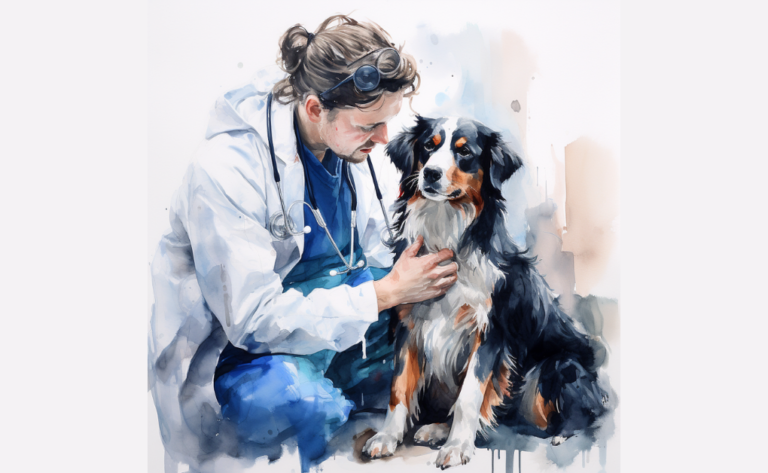Canine Distemper: Causes, Symptoms, Treatment & Prevention
What is it?
How is it Treated?
Breed Predispositions
All dog breeds are susceptible to Canine Distemper, but puppies and dogs with weakened immune systems are at higher risk of contracting the disease. Dogs that have not been vaccinated against the virus are also more likely to get infected.
As pet owners, we do our best to keep our furry friends healthy and happy. However, sometimes despite our efforts, our pets can fall ill with serious conditions that can be difficult to manage. One day, a pet owner named Alex noticed that his beloved German Shepherd, Rocky, was showing signs of lethargy, fever, coughing, and discharge from the eyes and nose. After taking Rocky to the veterinarian, it was discovered that he had Canine Distemper, a highly contagious viral disease that affects dogs of all ages and can be fatal if left untreated.
Canine distemper is a highly contagious and potentially life-threatening viral disease affecting domestic dogs and wild animals worldwide. As a responsible pet owner, it’s crucial to understand the causes, symptoms, and preventative measures associated with this severe illness.
Domestic and wild animals can fall victim to canine distemper, making it essential to be aware of its risks to puppies, dogs, and wildlife. Infected dogs can shed the virus, contributing to its spread among other animals. In addition, the virus initially replicates in the lymphatic tissue and can be particularly dangerous to puppies, underscoring the importance of early vaccination and preventive measures.
Older dogs may also be susceptible to this illness, so vigilance is crucial for dogs of all ages. Canine distemper does not discriminate between domestic dogs or wild animals, meaning any creature can be affected and contribute to its spread. Being aware of the risks of canine distemper, and taking precautions, such as vaccination, can help protect your dog from this disease and other illnesses like canine parvovirus.
What Causes Distemper in Dogs?
Canine distemper is caused by the canine distemper virus (CDV), a single-stranded, enveloped RNA virus belonging to the Morbillivirus genus within the Paramyxoviridae family.
Distemper in dogs is related to the viruses responsible for measles in humans. The virus primarily targets dogs’ respiratory, gastrointestinal, and nervous systems. One factor that increases pets’ chances of contracting the disease is direct contact with infected dogs or indirect contact with contaminated objects, such as food, bowls, toys, or bedding.

Another cause of canine distemper is contact with a wild animal carrying the virus, such as raccoons, foxes, or skunks, as they can also spread the virus to domestic dogs. The virus can be transmitted through the air via respiratory droplets from an infected dog’s cough or sneeze, increasing the likelihood of spreading the virus among animals.
When a dog is infected with CDV, it can experience a range of symptoms of distemper, including fever, nasal and eye discharge, coughing, sneezing, loss of appetite, vomiting, diarrhea, and neurological signs like seizures, tremors, or paralysis. The virus initially attacks the lymph nodes before spreading to other body parts.
Although the primary cause of canine distemper is CDV, a secondary bacterial infection may develop due to the weakened immune system, further complicating the disease; puppies and unvaccinated dogs are at the highest risk of contracting the disease.
Vaccination remains the most effective method for preventing canine distemper and maintaining immunity against the virus, thus increasing your pet’s chances of staying healthy. It is essential to be aware of the symptoms of distemper to protect your dog from this dangerous disease and limit its transmission to other animals, including wild animals.
Symptoms of Canine Distemper
The most common symptoms of canine distemper caused by a virus include:
- fever
- loss of appetite
- coughing
- runny nose and eyes
- vomiting
- diarrhea
- seizures
- paralysis
- neurological disorders
Pups infected with distemper may also develop “hard pad disease” or lesions on their feet or legs due to the virus attacking nerve cells. If left untreated, these potential CDV symptoms can worsen over time, emphasizing the importance of seeking veterinary care promptly if you suspect your pup may have been exposed to the canine distemper infection.
First Stage Symptoms:
Stage One of Canine Distemper is the most critical and time-sensitive phase. Signs of canine distemper can include:
- watery or pus-like discharge from bloodshot eyes
- fever
- loss of appetite
- clear nasal discharge that can quickly lead to thick mucousy nasal discharge and more severe symptoms

Sometimes, the virus can pass through the placenta to their puppies. It is essential to seek veterinary care immediately during this stage, as no treatments are available to cure canine distemper. However, with a prompt diagnosis and supportive care, many pups can recover fully after being adequately cared for by a veterinarian.
Remaining vigilant to detect any signs of distemper early on is crucial. Vaccinations protect against the virus and help prevent its spread further. By being proactive with your pet’s healthcare needs, you can ensure their safety and well-being for many years!
Second Stage Symptoms:
Stage Two of Canine Distemper can be challenging for both pet and owner. At this stage, the virus has spread to the respiratory system, causing:
- severe coughing
- sneezing
- nasal discharge
- difficulty breathing
If left untreated at this stage, the virus can quickly become fatal due to pneumonia or other complications. Neurologic signs may also appear.
To begin treatment, you must seek veterinary care as soon as possible if you suspect your dog may have distemper. Treatment typically involves antibiotics and supportive care, such as IV fluids, to keep your pup hydrated and healthy. With prompt diagnosis and proper treatment, many dogs can fully recover from distemper in Stage Two.
Diagnosis of Canine Distemper
Diagnosing canine distemper can be challenging, as the symptoms often overlap with those of other illnesses. Consequently, veterinarians rely on clinical signs, patient history, and laboratory tests to accurately diagnose the disease.
- Polymerase chain reaction (PCR) test: This sensitive molecular test detects the presence of the virus’s genetic material in bodily fluids, such as blood or nasal and ocular secretions. A positive PCR result strongly indicates an active distemper infection.
- Serology: Veterinarians may perform a serology test to detect the presence of antibodies against the canine distemper virus in the dog’s blood. A rising antibody titer over time suggests an active infection or recent exposure to the virus.
- Cytology: Examining cell samples from the dog’s conjunctiva, nasal discharge, or cerebrospinal fluid under a microscope may reveal the presence of viral inclusion bodies or other cellular changes indicative of a distemper infection.
- Additional tests: Veterinarians may also run blood tests to assess the dog’s overall health, including a complete blood count (CBC) and blood chemistry profile. These tests can help identify secondary infections or other health issues that may be present alongside distemper.
It is important to note that no single test is definitive for diagnosing canine distemper, and veterinarians often use a combination of these diagnostic tools, along with clinical signs and patient history, to make an accurate diagnosis. In addition, the dog’s strength plays a role in its recovery, and early detection and supportive care are crucial in managing the disease.
In cases where dogs are around other canines, it is essential to be vigilant and monitor for any symptoms, as distemper can spread rapidly between a healthy dog and an infected dog. Taking appropriate precautions can help protect your pet and improve their chances of recovery.
Treatment for Canine Distemper
Treatment for canine distemper primarily involves supportive care to manage the symptoms and help the dog’s immune system combat the virus. As there is no specific treatment or cure for canine distemper, veterinarians focus on alleviating the clinical signs and preventing secondary infections. This may include:

- Administering fluids to combat dehydration
- Providing electrolyte supplementation
- Ensuring proper nutrition to maintain the dog’s strength
In addition to supportive care, veterinarians may prescribe:
- Antibiotics address secondary bacterial infections due to a weakened immune system.
- Anti-inflammatory medications and anticonvulsants may be used to manage inflammation and seizures if these symptoms present.
In severe cases, hospitalization and intensive care may be necessary to monitor the dog’s vital signs and provide oxygen therapy or other life-saving measures. However, the most effective way to prevent canine distemper is through vaccination. Therefore, the distemper vaccine is crucial to a dog’s routine healthcare plan. In addition, it is essential to ensure that dogs receive their initial vaccinations and regular booster shots to maintain immunity against the disease.
How to Prevent Canine Distemper
Preventing canine distemper is crucial for maintaining your pup’s safety and health. Vaccination is the most effective method to minimize the risk of your dog contracting this potentially devastating infectious disease caused by a virus. Puppies should receive their first vaccination at 6-7 weeks old, followed by booster shots every 3-4 weeks until 16 weeks.
For adult dogs, boosters can be administered yearly or every three years, depending on your veterinarian’s recommendation. Additionally, it’s vital to stay on top of other preventive measures, such as regular checkups, parasite control, and monitoring contact with wildlife, to ensure optimal health for your pup.
Taking the time to safeguard your pup from canine distemper is one of the most critical responsibilities of a pet parent. While this virus can have severe consequences and dogs can shed the virus, proper prevention will help ensure your pup stays healthy and happy for many years. In case of symptoms, seek immediate veterinary attention to prevent distemper outbreaks and facilitate recovery from canine distemper.
Frequently Ask Questions
Disclaimer: The information provided on this veterinary website is intended for general educational purposes only and should not be considered as a substitute for professional veterinary advice, diagnosis, or treatment. Always consult a licensed veterinarian for any concerns or questions regarding the health and well-being of your pet. This website does not claim to cover every possible situation or provide exhaustive knowledge on the subjects presented. The owners and contributors of this website are not responsible for any harm or loss that may result from the use or misuse of the information provided herein.







